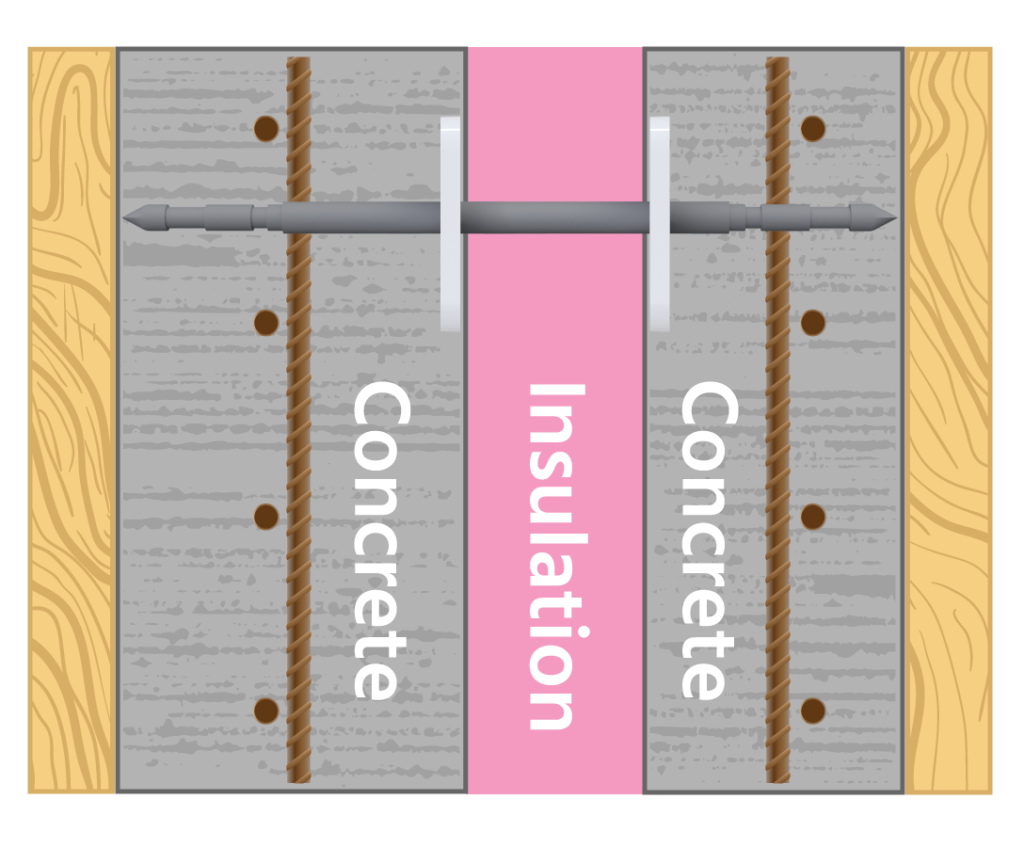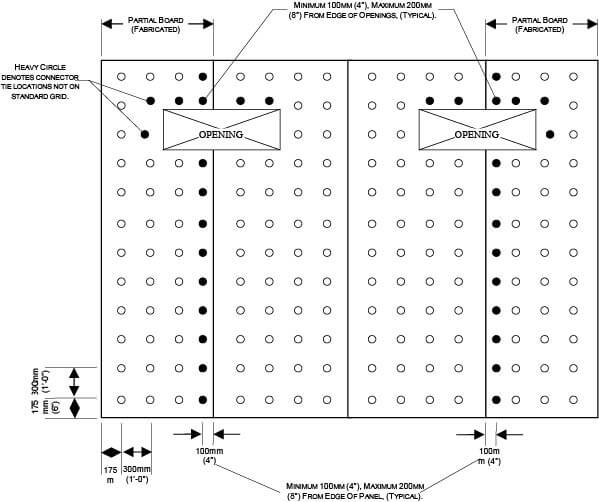Application
HK Vertical Pour (VP) ties may be used in most modular precast and cast-in-place applications where the following conditions apply:
- The fascia, or outside layer, is 75mm (3″) thick or less for modular precast applications.
- Fascias 10 feet or taller are unsupported, if wall section has 50mm thick rigid insulation, or use VPT ties for tall walls (fascias less than 10 feet tall may be supported or unsupported).
- The concrete compressive strength at the time of lifting is at least 17.2Mpa (2,500 psi).
For your convenience, you can download these instructions as a printable PDF.
These instructions replace the previous document titled “Installation Instructions Pub. No. HK-VP-II”
Disclaimer of Liability
It is the sole responsibility of the contractor to install the HK ties in accordance with the published instructions. It is also the responsibility of the owner to confirm proper industry standards and methods are used by contractors, engineers, suppliers, and all others hired by the owner. The presence of an HK Composites representative at the job site does not relieve the contractor from the responsibility to follow published installation instructions. HK COMPOSITES IS NOT RESPONSIBLE FOR ANY LIABILITY RESULTING FROM A FAILURE TO FOLLOW THESE INSTRUCTIONS. Our recommendations should not be taken as a construction specification nor inducements to infringe on any patent or violate any law, safety code or insurance regulation.
Installation Instructions
The HK Vertical Pour (VP) tie is designed to work with two clips per tie to hold the rigid insulation in place during casting. The clips fit into recessed areas on the tie.
HK panel ties for Vertical Pour (VP) applications are specifically designed for use in cast-in-place and modular precast applications. They provide a fast, efficient method of insulating concrete structures without compromising the low-maintenance/high durability of concrete walls.
Each sheet of insulation should be marked on one side with dots on 305mm (12-inch) centers, indicating where ties would normally be inserted into the rigid insulation.
- Attach one clip to the tie. The clip slides into the recessed area on the tie from the side. The two retention arms of the clip will snap into place first. Positive retention is ensured when you hear a second “click” and the clip is properly seated on the tie.
- Push the tie with one clip through the rigid insulation at a location marked by a dot.
- Move to the other side of the rigid insulation and slide the second clip into the recessed

Repeat the above steps for each tie.

Around Openings / At Panel Edges
Ties should be no closer than 100mm (4″) and no further than 200mm (8″) from the edge of the rigid insulation. In these cases, you may need to either shift ties away from the panel edges or openings or add extra ties so this spacing is maintained.
Concrete Placement
While placing the concrete inside the forms, place the concrete on either side of the rigid insulation as equally as possible. Make certain the concrete level on one side does not vary from the level on the opposite side by more than 18 inches.
Additional Questions
We understand what it means to gain client trust, which is why we develop durable, sustainable concrete construction products.
In addition to providing top of the line products, our customer support team and engineering team work hard to ensure our clients are satisfied. If you have any questions about the HK Composites products, please contact us. We’d be happy to assist.
Contact Us
Toll Free:
(800) 430-6316
International: +1 801-763-0907
Frequently Asked Questions
How do HK Ties work?
View the "How it Works" page to see a demonstration video.
Are HK Ties Tested?
Yes. Our patented low-conductivity polymer systems excel in tests for tensile strength, shearing, concrete pull-out, long term alkaline resistance, fire, cyclic fatigue, and many building code certifications. See HK testing reports here.
Do I save money using HK Ties?
Yes. Our simple manufacturing process used to make HK Ties, called thermoforming, reduces our output costs which increases your “bang for your buck”. Not only that, HK Ties reduce the R-value of the wall by less than 1% compared to as much as 75% reduction with steel and/or typical solid concrete section ties. This results in maximum energy savings!
Also, because HK Ties are manufactured using a simple process, they cost less to produce and we can pass along that savings to our users.
Does HK use fiberglass to make Ties?
Being the best means being different; we don’t use fiberglass in our HK Standard Ties. HK Standard Ties are made from an engineered reinforced thermoplastic, enabling our standard ties to be more durable than competitor ties. In contrast, HK Vertical Pour/ Modular Precast Ties and Composite Action Ties are made from a fiberglass reinforced thermoplastic.
Regardless of the engineered make-up, all HK Ties are designed to resist impact and shock loads during precast panel transportation and erection. The resin retains its strength at high temperature and provides maximum long-term chemical resistance.
Construction jobs come in many different shapes and sizes. Different jobs require different ties. Our HK Tie experts are here to help you find the best tie for your project. Contact us today!
Is plastic as strong as fiberglass?
Fiberglass is plastic—reinforced with glass fiber. Strength-wise, it is true that some types of fiberglass have a higher material tensile strength than HK Tie resins. However, high material tensile strength is only one factor responsible for the tensile capacity of a tie. The minimum cross-sectional area and manufacturing processes together with inherent material properties ultimately determine tie strength. The actual delivered tensile and shear strengths of HK Ties are many times higher than required.
The plastic used for the HK Standard Ties is a high-impact, high-temperature, chemical resistant engineered thermoplastic. The plastic used for the HK VP (Vertical Pour) and Modular Precast Ties is glass fiber reinforced.
Every job is another dragon to slay. We will help you get the job done cost-effectively, safely and as quickly as possible. Contact us today!
Can my project receive LEED points for using the HK Building system?
Yes. With the HK building system, you can go green and save green. HK Green Building Insulation Systems are designed to meet green building standards for better thermal protection and energy performance from longer-lasting, environmentally benign building materials.
The system is created using extruded polystyrene foam (XPS) insulation in-between two concrete wythes. Highly durable HK Ties, inserted into the XPS, have been proven to reduce the insulation R-value by less than 1% Compare that to as much as 75% reduction with steel and/or typical solid concrete sections! This small change can make a big difference! Start saving and contact us today.
Does HK offer a turnkey solution?
Yes. Our turnkey foam fabrication solution is one of many reasons why we are the concrete sandwich construction industry leader. We specialize in and have extensive experience with foam fabrication processes.
When the foam is fabricated, boards are pre-cut to fit architectural drawings. We make it easy for you as we provide specific foam layout drawings and pre-drill the XPS energy-efficient insulation board to accommodate HK Tie insertion. HK insulation foam boards come to the job site, placement ready. Bye, bye head scratching and complicated puzzles, hello revenue.
